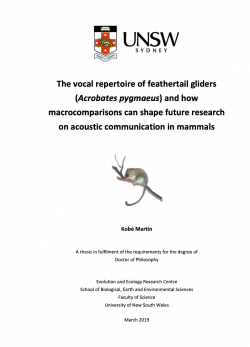The vocal repertoire of feathertail gliders (acrobates pygmaeus) and how macrocomparisons can shape future research on acoustic communication in mammals

Type
Thesis
Authors
Martin ( Kobé Martin )
Category
Thesis
[ Browse Items ]
Publication Year
2019
URL
[ private ]
Abstract
Australia is home to the largest diversity of marsupial mammals in the world. It also has one of the highest extinction rates of animals in the world. The use of acoustics in environmental monitoring is growing in popularity, and it is important to have a solid knowledge of the acoustic repertoires of those species at risk from urbanisation and deforestation in order to be able to monitor them in the wild. The aim of this thesis was to add to our knowledge of the gliding marsupials by describing the vocal repertoire of the smallest gliding marsupial, the feathertail glider, and using macrocomparative techniques to determine where they fit in the broad scale of mammalian acoustic communication.
This was the first acoustic description of the feathertail glider’s vocal repertoire, and the first description of ultrasonic vocalisation for gliding marsupials. I found that feathertail gliders produce a diverse and highly complex vocal repertoire which is representative of their social lifestyle. The frequencies of their vocalisations are also well matched to their hearing sensitivity. I found that a subset of their ultrasonic call types was produced purely in the ultrasonic range, whereas two of the broadband call types extended from the audible to the ultrasonic range. The calls produced in the ultrasonic range are highly stereotyped, making them ideal for potential use in passive acoustic monitoring of the species.
A macrocomparison of the vocalisation frequencies of 193 species, and the hearing limits of 126 species of mammals found that body size and environment had a large influence on the limits a species communicates at. Aquatic species utilise higher frequency vocalisations and hearing than terrestrial species of similar body mass, demonstrating that the divergence of signal frequencies in mammals has arisen from the need to adapt to their environment. The results of these macrocomparison studies have extended our knowledge of the influence of life history traits on the acoustic communication of mammals, a topic of increasing interest and importance in an increasingly noisy world.
This was the first acoustic description of the feathertail glider’s vocal repertoire, and the first description of ultrasonic vocalisation for gliding marsupials. I found that feathertail gliders produce a diverse and highly complex vocal repertoire which is representative of their social lifestyle. The frequencies of their vocalisations are also well matched to their hearing sensitivity. I found that a subset of their ultrasonic call types was produced purely in the ultrasonic range, whereas two of the broadband call types extended from the audible to the ultrasonic range. The calls produced in the ultrasonic range are highly stereotyped, making them ideal for potential use in passive acoustic monitoring of the species.
A macrocomparison of the vocalisation frequencies of 193 species, and the hearing limits of 126 species of mammals found that body size and environment had a large influence on the limits a species communicates at. Aquatic species utilise higher frequency vocalisations and hearing than terrestrial species of similar body mass, demonstrating that the divergence of signal frequencies in mammals has arisen from the need to adapt to their environment. The results of these macrocomparison studies have extended our knowledge of the influence of life history traits on the acoustic communication of mammals, a topic of increasing interest and importance in an increasingly noisy world.
Description
https://doi.org/10.26190/unsworks/21131
Number of Copies
1
| Library | Accession No | Call No | Copy No | Edition | Location | Availability |
|---|---|---|---|---|---|---|
| Main | 658 | 1 | Yes |




